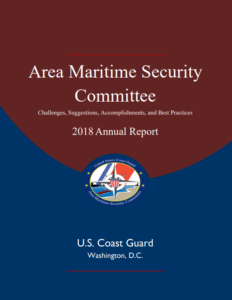The Office of Port and Facility Compliance of the USCG has announced the publication of an enhanced report on the status and work completed by Area Maritime Security Committees (AMSCs) for 2018.
In fact, it is said that
AMSCs bring together security and industry experts in order to initiate efforts that support a secure and collaborative maritime domain.
In particular, the 43 AMSCs submit an annual report to the Office of Port and Facility Compliance (CG-FAC) detailing their activities and common issues relating to challenges, suggestions, accomplishments and best practices. This report then helps CG-FAC and other program offices to create national strategies to address mutual problems and emerging threats.
Some of the challenges addressed relate to
- Cybersecurity and the MTS: The dynamic nature of cybersecurity threats and the shortage of subject matter experts in government and industry make cybersecurity preparedness, response and recovery a continuing challenge. The reports also highlight a concern in reference to stakeholders applying for Port Security Grant Program (PSGP) funding to initiate cybersecurity projects due to the limited guidance on cyber, and the lack of in depth field knowledge to properly assess the cybersecurity investment justifications during the PSGP field review.
- Homeport 2.0: Homeport, the internet portal utilized by the Coast Guard, which facilitates the sharing of information between Coast Guard personnel, members of the maritime community, and other designated port stakeholders, continues to be a challenge for management of accounts for members and the ability to effectively communicate to the maritime stakeholders. AMSC members are discouraged from using the Homeport enterprise system due to the difficulty in maintaining access and the multiple error messages that they encounter as they attempt to navigate in the current system.
- Port Security Specialist (PSS) expansive responsibilities: The workloads have increased since the inception of the PSS billets potentially impacting relationships with local communities and port partners. The PSS may not be able to participate in state and local exercises and attend state and local security related committees due to the number of assigned missions.
- Maintaining AMSC Membership: AMSCs struggle with nurturing the high level of interest needed to maintain a vibrant port security program.
- Active Shooter (AS)/Active Threat (AT): A common concern was the level of training, the type of gear, and weapons needed to respond to an AS/AT incident in the maritime domain.
Some of the suggestions proposed are the following
- Cybersecurity and Cyber Risk Management: AMSC cyber subcommittees must continue to foster an open information sharing environment for port partners and leverage the available subject matter expertise to highlight critical nodes and identify existing cybersecurity vulnerabilities. Further to this, the Coast Guard should continue to seek funding for cybersecurity training and expertise to meet these challenges. In particular, cybersecurity training should be tailored for AMSC members that increases awareness of cybersecurity issues and ways to mitigate cyber vulnerabilities.
- Homeport 2.0: A recurring suggestion from field units is to tailor Homeport 2.0 to meet or exceed the functionality of Homeport 1.0.
- UAS: The Coast Guard and the Department of Homeland Security (DHS) can support the acquisition of UAS capabilities for federal, state, and local law enforcement and emergency response agencies through direct appropriations and appropriate grant program prioritization. Additionally, the Coast Guard and DHS can support the creation of techniques, tactics, and procedures for interoperability and information sharing to improve situational and domain awareness to reduce risk in the port environment.
- Active Shooter (AS) and Active Threat (AT) Incidents: AMSCs suggest that CG Headquarters update or expand policy guidance in reference to AS/AT incidents. Training and proper equipment to meet policy requirements needs to be addressed. AMSCs recommend passenger vessel crews need specific training and guidance to address AS/AT Threats.
- AMSC Support Funds: It is recommended that funding be identified for restoration of a national conference or event to be held for AMSC leadership. This provides for crucial collaboration time with Committees from around the nation and facilitates the employment of best practices as shared in these reports.
Notably, AMSCs still have a role in identifying, analyzing, prioritizing, and mitigating both physical and cyber related challenges in the MTS to advert potential adverse impacts to critical waterways and ensure efficient facilitation of commerce.
It is lastly said that
through collaboration, planning, coordination, open lines of communication, and unity of efforts, AMSCs have proven to be and remain essential to addressing new issues and emerging threats that could impact our national security and economic interests.
You can explore more by clicking on the PDF bellow.
































































